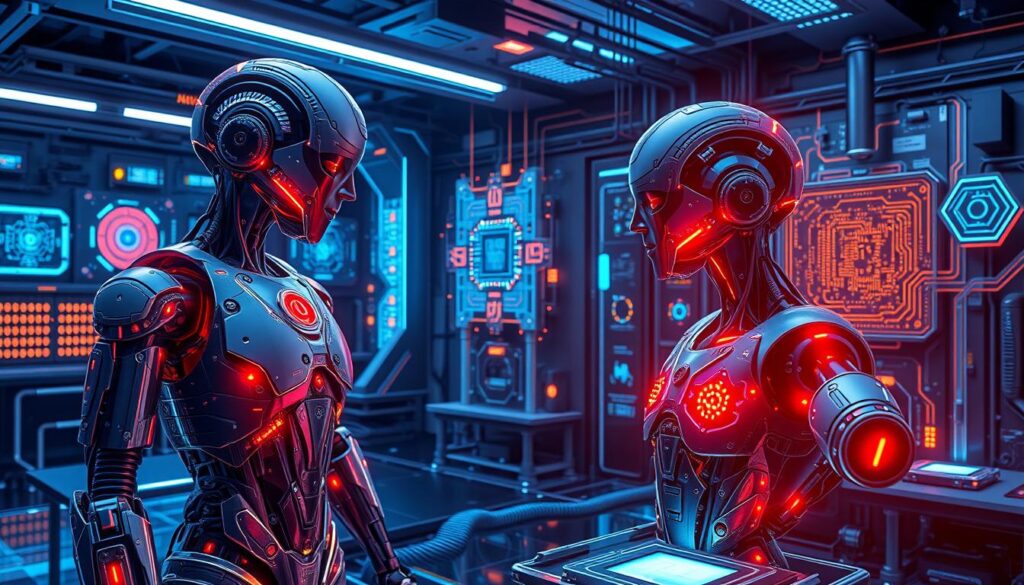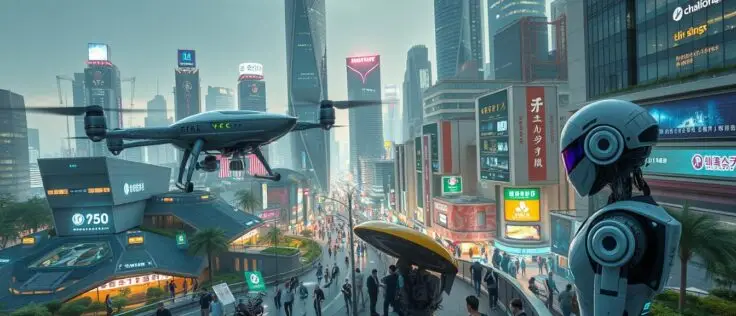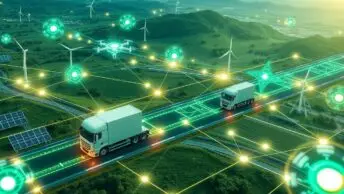Have you thought about how AI and Robotics will change our lives? We are at the start of a new tech era. This era has machines with artificial intelligence becoming part of many areas of our lives. They are bringing big changes in fields like manufacturing, healthcare, and farming. This is due to quick progress in machine learning, neural networks, and data analysis.
The journey began with the Unimate robot in 19611. Now, we see complex robots from companies like Boston Dynamics1. This combination has brought new levels of work efficiency and accuracy. It is changing current industries and creating new ones. This changes how society works and affects the job market. As AI keeps growing, it will keep changing how we see technology and automation.
Robots are already doing surgeries, like with the da Vinci Surgical System1. This makes operations more precise and helps patients recover faster. The growth of AI and better computing in the late 20th century improved robots’ sensory and motor skills1. This shows the fast progress in these technologies.
While there’s excitement about the future, we can’t ignore the challenges. These include privacy issues, ethical concerns, and technical hurdles1. It’s important to use these technologies carefully. Thinking about the future, imagine how AI and Robotics could shape our world. Consider what this means for you in an automated world.
Unveiling the Evolution of AI and Robotics
The journey of Robotics AI began in the mid-20th century. It started with the Dartmouth Conference in 1956 and the creation of the first industrial robot, Unimate. Since then, the bond between robotics and AI has only gotten stronger. The 1980s and 1990s saw major progress, like better AI algorithms and a focus on improving robots’ sensory and motor abilities.
Robots today are more than tools for simple manual work3. They can think, understand, and learn, making quick decisions in fields like manufacturing, healthcare, and logistics. Especially in manufacturing, AI-enhanced robots are vital3. They boost productivity, cut down on costs, and drive innovation.
AI sensors have been key in advancing robotics3. They improve how robots operate in shared spaces, helping them work better with humans. This blend of technology is transforming industries, changing how we do things, and altering the human-machine link.
We are heading towards a future where AI sensors and robots change how sectors operate3. This will lead to more adaptable, smart, and intuitive robotic systems, deeply woven into our industrial and social lives. It highlights the need for careful, ethical development. Check out how AI is revolutionising marketing strategies for more insights into AI’s impact.
The Core Technologies Behind AI and Robotics
The development of artificial intelligence (AI) and robotics has moved from just ideas to real-world uses in many fields. Key technologies like machine learning, neural networks, natural language processing, and machine vision4 play a central role. They not only make robots more skilled but also allow them to be used in everything from daily life to complicated industrial jobs.
Machine Learning and Robotics AI
Machine learning is a leading tech in robotics AI. It lets robots learn from data, making them smarter over time. By using AI sensors, robots can understand complex information from their surroundings. This helps them work better in challenging situations. Investments in machine learning hit nearly 1 billion US dollars from 2011 to 20145.
Neural Networks Enhancing Robotic Functions
Neural networks create decision-making that is similar to how human brains work. They bring sophisticated learning to robots. This is key for recognizing patterns, which is vital in changing environments. It’s especially important in healthcare for precise and adaptable actions.
Advancements in Natural Language Processing for Human-Robot Interaction
Natural language processing has greatly improved interaction between humans and robots. Robots can now understand and speak human language in context. This makes them better at tasks that need understanding and care, like in customer service and personal care.
Computer Vision and Its Impact on Machine Perception
Computer vision has changed the way robots see their surroundings. Thanks to advanced algorithms, robots can analyze and comprehend visual data. This is crucial for jobs that need a lot of precision, like surgery and self-driving cars. Funding for machine vision has been huge, reaching hundreds of millions since 20115.
The Role of AI and Robotics in Modern Manufacturing and Industry 4.0
Industry 4.0 has changed manufacturing dramatically. It mixes advanced robotics and smart techniques with traditional methods. This blend enhances operations and boosts productivity. The use of AI helps with predictive maintenance and improving control over processes, pushing the sector ahead6.
In the UK, AI and Industry 4.0 could reshape jobs. Although automation may transform some jobs, it also creates new ones. These new roles often involve complex problem-solving. Studies indicate that robotics and Industry 4.0 could replace mundane tasks. Yet, they’re also likely to create jobs, especially in engineering and architecture7.
Moreover, AI does not just change things inside factories. It transforms supply chains and logistics too. This helps companies meet customer needs better and use resources more wisely6. By using machine learning and AI, businesses can decide faster, make fewer mistakes, and react quickly. These are crucial for staying ahead in the current market6.
Global industries are adopting automation and smart manufacturing more and more. By doing so, they make their operations smoother and move towards stronger, more adaptable production systems. The smart use of robotics and AI in Industry 4.0 doesn’t just change how things are made. It also leads to better business models with high automation and efficiency levels6.
Exploring the Rise of Autonomous Systems
Various sectors are now embracing autonomous systems, changing the tech world. These systems use advanced AI to push robotics forward. This shift makes autonomous technologies key in today’s tech scene.
SLAM Technology Propelling Robotic Navigation
SLAM technology stands out in autonomous progress. It lets robots move and map complex places by themselves. For instance, robots like Boston Dynamics’ Spot can work solo in difficult areas thanks to SLAM. This is especially useful where it’s too dangerous or not possible for people to be.
Adapting to Real-time Data for Unpredictable Environments
Today’s autonomous systems can adapt quickly. They use deep learning to get better at handling new information. This means robots can cope in changeable places without old maps or plans. Such tech is now being used in places like rescue missions and factory work. Adding AI to marketing through smart automation and predictions also boosts customer interaction and sales revenue growth8.
Humanising Technology: The Growth of Human-Robot Interaction
The growth of human-robot interaction is key in the robotics AI field. It uses NLP and affective computing so robots can understand human feelings. In places like healthcare and customer service, this tech is changing how we get services. For example, AI like OpenAI’s GPT-3 lets robots talk more naturally with humans. This improves the experience and makes things more efficient9.
As robots and humans interact more, NLP’s role gets bigger in helping them communicate effectively. Robots are now learning to pick up on how we speak and our facial expressions. They’re doing tasks once thought too complex for machines.
Bill Gates’ idea to tax robots highlights the economic effects of robotics in work. This robot tax idea brings up many questions about financial impacts when robots take over human jobs10. It shows how work is changing with robotics AI.
To learn more about this, explore how AI-driven content strategies are changing things. This is through machine learning and robotics. It’s making digital marketing more personalised and precise worldwide.
Adding human traits to robots isn’t just for different sectors. It is also sparking important conversations about how we treat these artificial beings that look like us.
AI-Driven Robotics Transforming Healthcare
AI is changing healthcare, especially with autonomous systems and AI-driven robotics. These developments are creating new benchmarks for precision and efficiency in medicine. Optimising e-commerce with automated pricing strategies shows how AI automation is affecting more than healthcare12.
AI-powered robotics are improving crucial healthcare areas like surgery, eldercare, and rehab.
The Surge of Robotics in Surgical Procedures
AI is making surgeries better by using robots for more precision and control. Robots can check and interpret mammograms 30 times quicker with 99% accuracy, cutting down on unneeded biopsies. This means faster and more accurate diagnoses for patients12. AI is also changing how drugs are developed, making it cheaper and faster12. Surgery with robots helps doctors work more accurately, leading to quicker recovery and better results13.
AI Robots As The New Frontline in Eldercare and Rehabilitation
With more people getting older, the need for good elderly care is growing. AI robots are becoming important for offering companionship and support. This helps the elderly stay somewhat independent13. In rehab, these robots create personalised therapies, which means better engagement and faster recovery13. AI in healthcare makes sure care is always top-notch and continuous.
Groundbreaking Robotics AI Applications in Agriculture
The use of robotics AI in farming is changing the game completely. These technologies make farming more accurate. They help with big challenges like not having enough workers, needing to farm sustainably, and having to grow more food for the increasing population. This population is expected to grow by 70% by 205014. AI brings together top efficiency and care for our environment.
In the USA, Verdant Robotics has created a machine named SprayBox. It can spot and treat weeds and crops very well and fast. It can handle up to 500,000 plants in an hour while using fewer chemicals15. In Europe, French startups have done amazing things too. They raised over 200 million euros in 2022. This shows how much potential there is in this field15.
AI-driven tools are making farm work easier in many places. The Dexterous Hand by Shadow Robot and AI drones from Tevel have robotic arms. They do farm jobs in countries like Israel, the USA, and Italy. They save a lot of time that people would have spent working16. The Carbon Robotics LaserWeeder is another cool invention. It reduces the cost of getting rid of weeds by 80% and works all day and night16.
Small Robot Company has made three robots called Tom, Dick, and Harry. They’re small but very smart. They work together to check on and look after crops. This helps a lot with planting and weeding. It’s a great answer to not having enough farmworkers, a problem that’s getting worse because of cities growing and farmers getting older14.
Robotics AI in farming means more than just machines doing work. It’s about farming in a way that’s good for tomorrow. AI is changing and growing. It seems like it can do almost anything in farming. This promises a farming future that’s better for the planet, more effective, and produces a lot.
Working Side by Side: AI and Collaborative Robots (Cobots)
The rise of collaborative robots, or cobots, marks a key change in industrial automation. These cobots are made to work with human workers. They help and boost human work in many areas. By 2024, their use in manufacturing will be especially noticeable. This shows their growing popularity and usefulness17.
Cobots are different from old industrial robots because they’re easier to use. People can easily set them up and add them to current work processes18. They can even learn and decide things quickly because of their advanced technology17. Cobots are designed to be safe around people. They have special sensors, smooth edges, and padding to make the workplace safer18.
Learning Through Demonstration: A New Frontier for Cobots
These smart machines are more than just tools; they’re learning partners. They can learn from people showing them how to do things. This helps them get better and work well in different jobs. They are perfect for jobs that need changes and are fast-paced18.
The Expanding Role of Cobots in Industry and Healthcare
In healthcare, cobots are making big changes by helping with many tasks. They help with everything from checking on patients to aiding in complicated surgeries. This improves care and safety for patients. Cobots are also used in areas like healthcare and logistics. This leads to better efficiency and sparks new ideas17. As technology moves forward, cobots become more important. They bring together human skills and robotic accuracy in a new era of industrial automation.
Mitigating Challenges: Data Privacy and Ethical Considerations in AI Robotics
The growth of AI robotics highlights key concerns with data privacy and security. As AI embeds itself in different sectors, there’s a big challenge for regulators and organisations. They need to make sure these technologies are used rightly. The CCPA in California and the European Union’s GDPR take essential steps in tackling privacy and security worries raised by AI technologies19.
The issue of ethical robotics is also filled with challenges. The White House has put $140 million into facing ethical issues in AI. This shows how crucial it is to have rules for ethical use of robotics technologies20. Also, it’s important that ethical rules do more than just stick to laws. They must help build real trust and teamwork between the public and those involved.
Tackling ethical problems in AI, like job loss and biased algorithms, is critical. The Artificial Intelligence Act (AIA) points out the need for clear and understandable AI. This helps fight bias and keeps AI ethically responsible19. Also, as AI automation grows, it might replace many jobs. This calls for actions such as retraining programs to lessen economic divides20.
To keep AI and robotics ethically sound, everyone must work together. This means technologists, policymakers, ethicists, and the public coming together. Such teamwork is key to setting standards that respect both technical needs and ethical values20. As we move deeper into the robotics era, it’s essential that these machines act within ethical and legal standards. This is not just wise but necessary.
Revolutionary Breakthroughs and Recent Progress in AI Robotics
The world of AI and robotics is growing fast, with big steps forward that could change everything. Leading the charge are neuromorphic and quantum computing. These fields are making robots smarter and more capable than ever before.

Neuromorphic Computing: Replicating Human Brain Processes
The Quantum Leap: How Quantum Computing is Reshaping Robotics AI
Quantum computing is reshaping AI in robotics too. It can deal with huge amounts of data very fast2122. This is key for machines to learn and make choices faster. In healthcare, robots are becoming more precise, helping patients recover quicker22. Quantum computing is also pushing innovations in space and making daily interactions with robots smoother.
To wrap up, mixing neuromorphic and quantum computing is not just making robots work better. It’s also paving the way for amazing new things in AI robotics. This could lead to smarter, more intuitive robots that play a big part in different fields.
Conclusion
The future shines bright with the merger of AI and robotics, creating endless opportunities. This wave of innovation is reshaping many sectors, such as healthcare and manufacturing23. In healthcare, robotics has reached a point where surgeries are more precise, thanks to AI. This boosts how well we can care for patients24. In farming, AI and robots work together to make farms more productive and efficient24.
This blend of technology brings about a new age where humans and robots work hand in hand. This partnership is not just about getting work done but boosting creativity25. This bond is key for developing future tech in the UK and other places. Yet, we must think about the ethical side and how it affects society. It’s important to ensure this tech growth also cares for our values.
Looking forward, AI in robotics is starting a big change. It makes robots work with more precision and quality23. This pushes companies to a new level of success. They should see this tech as essential for staying ahead in the future. As AI keeps growing, we all need to stay aware and ready for what’s next25.
FAQ
What advancements define the future of AI and Robotics?
Future advances in AI and robotics are set to bring robots that work more on their own. They’ll be more precise in different fields. We’ll see better conversations between robots and humans because of new tech in understanding language and emotions. Robots will also process data faster thanks to quantum computing, making them smarter.
How has the evolution of Robotics AI and industrial robots unfolded over time?
The journey of Robotics AI and industrial robots started in the mid-20th century. It kicked off with the creation of Unimate, the first industrial robot. Then, in the ’80s and ’90s, robots got smarter with better AI algorithms and could sense their surroundings better. Today, this evolution speeds up with advances in machine learning and data analysis.
What are the core technologies driving AI in robotics?
The main tech behind AI in robotics includes machine learning and neural networks. There’s also natural language processing (NLP) and computer vision. These let robots learn, decide on complex issues, chat with humans, and understand their world.
How is artificial intelligence revolutionizing modern manufacturing and Industry 4.0?
AI robots are making factory lines more effective, doing everything from building stuff to checking its quality. They work with great accuracy. AI also helps in predicting when machines might need fixing, saving time and money. This is changing modern manufacturing in the big move to Industry 4.0.
What role does SLAM technology play in autonomous systems?
SLAM technology makes it possible for robots to move around tricky spots on their own, making maps as they go. They don’t need maps given to them beforehand. This helps them know where they are in the map they create.
How is technology humanising the interaction between humans and robots?
Technology makes talking to robots more like talking to a person by improving NLP and understanding feelings. This makes working together smoother and more natural.
In what ways are AI-driven robots changing healthcare?
AI robots in healthcare are doing surgeries with pinpoint accuracy, helping experts, and aiding recovery and elderly care. They improve how well and fast patients are looked after. They also help medical staff manage their tasks better.
How is robotics AI influencing agriculture?
Robotics AI is reshaping farming by automating planting, weeding, and gathering crops. It uses machine vision to check on plant health and takes precise steps to help. This boosts how much food is grown and cuts down on harmful chemicals.
How are cobots learning from human demonstrations changing industrial automation?
Cobots are made to learn from humans by watching them. With smart AI, they learn new skills this way, adding to what tasks they can do. This is changing how factories and even healthcare work.
What are the major challenges surrounding data privacy and ethics in AI robotics?
The big issues are keeping all the data robots gather safe, dealing with job losses caused by robots, and using robots that make choices on their own. We also need clear rules to avoid bias in robot decisions and keep their actions open for checks.
What recent breakthroughs are shaping the future of AI robotics?
New discoveries like neuromorphic computing, imitating the human brain, and quantum computing are big news. They’re expected to change how robots process data and make decisions, leading the way in AI robotics.
Source Links
- What is the Future of AI in Robotics? – https://www.azorobotics.com/Article.aspx?ArticleID=700
- AIR Journey E1: The Evolution of AI in Robotics – ARTI – https://arti-robots.com/2024/02/26/air-journey-e1-the-evolution-of-ai-in-robotics/
- Unveiling Tomorrow: The Evolution of Artificial Intelligence in Robotics – https://www.linkedin.com/pulse/unveiling-tomorrow-evolution-artificial-intelligence-robotics-5gzee
- Robotics – https://kanerika.com/glossary/robotics/
- Five Core Technologies Of Artificial Intelligence – https://medium.com/born-to-lead/five-core-technologies-of-artificial-intelligence-5cea219f49ed
- Empowering Industry 4.0 with AI and ML: Transforming Operations and Efficiency – https://www.rowse.co.uk/blog/post/the-role-of-ai-ml-in-industry-4-0
- On AI and Robotics – https://policyatmanchester.shorthandstories.com/on_ai_and_robotics/index.html
- MSc Robotics, AI and Autonomous Systems | City, University of London – https://www.city.ac.uk/prospective-students/courses/postgraduate/robotics-ai-autonomous-systems
- Humanising Robots – https://www.futurelearn.com/info/courses/begin-robotics/0/steps/2846
- The growing problem of humanizing robots – https://medcraveonline.com/IRATJ/the-growing-problem-of-humanizing-robots.html
- The Growing Problem of Humanizing Robots – http://connect.informs.org/blogs/lionel-robert/2018/01/01/the-growing-problem-of-humanizing-robots
- No longer science fiction, AI and robotics are transforming healthcare – https://www.pwc.com/gx/en/industries/healthcare/publications/ai-robotics-new-health/transforming-healthcare.html
- AI-Driven Robotics Transforming Healthcare and Rehabilitation – https://www.linkedin.com/pulse/ai-driven-robotics-transforming-healthcare-rehabilitation-sonyc-io-cb5df
- Revolutionizing Agriculture with AI and Robotics: A New Dawn for Precision and Assistive Farming. – https://www.linkedin.com/pulse/revolutionizing-agriculture-ai-robotics-new-dawn-farming-umuhire-iia7f
- Robotics and artificial intelligence for agriculture – Hello Future Orange – https://hellofuture.orange.com/en/precision-agriculture-ai-enters-the-field/
- AI in Robotics: 6 Groundbreaking Applications – https://www.v7labs.com/blog/ai-in-robotics
- Robots in manufacturing: from AI to cobots – https://kiuey.com/robots-in-manufacturing/
- Cobots vs Robots: Understanding the Key Differences and Applications – https://www.wevolver.com/article/cobot-vs-robot
- Ethical Considerations in AI: Unraveling the Challenges and Responsibility – https://www.linkedin.com/pulse/ethical-considerations-ai-unraveling-challenges-john-halstead-phd-c1xdc
- The Ethical Considerations of Artificial Intelligence | Capitol Technology University – https://www.captechu.edu/blog/ethical-considerations-of-artificial-intelligence
- Exploring the Future: Revolutionary Breakthroughs in AI Robotics – https://www.linkedin.com/pulse/exploring-future-revolutionary-breakthroughs-ai-bhimarasetty
- Revolutionising Healthcare: The Impact of AI and Robotics – Deeper Insights – https://deeperinsights.com/ai-blog/revolutionising-healthcare-the-impact-of-ai-and-robotics
- The Impact of Artificial Intelligence on Robotics – https://www.linkedin.com/pulse/impact-artificial-intelligence-robotics-damien-soulé
- Artificial Intelligence in Robotics: (Review Paper) – https://www.ijraset.com/research-paper/artificial-intelligence-in-robotics
- AI and Robotics: The Integration of Artificial Intelligence in Automated Systems. – https://www.linkedin.com/pulse/ai-robotics-integration-artificial-intelligence-automated






